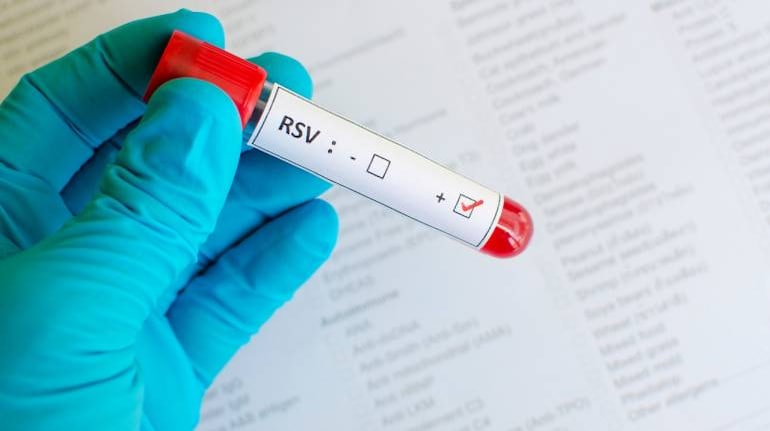Congenital disorders
RSV causes and symptoms: A threat to infants, here’s how you can protect them from the virus
RSV symptoms typically manifest 4 to 6 days after infection, starting with congestion and a runny nose. It evolves into coughing, sneezing, fever, and wheezing, often in sequence (Image: Canva)
As winter approaches, the risk of respiratory infections, including the flu, rises. One virus to watch out for is the Respiratory Syncytial Virus (RSV), which can lead to hospitalisations in both children and adults. RSV is primarily transmitted through airborne droplets from coughs and sneezes, as well as via direct contact with contaminated surfaces, making it highly contagious.
Respiratory Syncytial Virus (RSV), a respiratory infection, tiptoes into the lives of infants like a harmless breeze but swiftly transforms into a storm of severe complications. Initially, it looks much like a common cold, lulling caregivers into a false sense of security. But it can rapidly progress to more severe conditions, such as breathing difficulties and wheezing, in infants and young children.
RSV’s targeted vulnerability
RSV poses a significant threat to infants and young children, as per the Centres for Disease Control and Prevention (CDC) report. The most vulnerable groups include premature infants, infants under 12 months (particularly those aged 6 months or younger), children under 2 years with chronic lung disease or congenital heart conditions, those with weakened immune systems, and children afflicted by neuromuscular disorders, which can affect their ability to swallow or clear mucus secretions.
We consulted a few renowned pediatricians to understand RSV and its impact on infants.
Symptoms and progression:
Senior pediatricians Dr S.D. Sharma, Director and Head of the Department of Pediatrics & Neonatology at Eternal Hospital (EHCC) in Jaipur, explains RSV’s progression. “The symptoms typically manifest 4 to 6 days after infection, starting with congestion and a runny nose. It evolves into coughing, sneezing, fever, and wheezing, often in sequence. In the case of infants, RSV can lead to irritability, reduced activity, and breathing difficulties. Nearly all children experience RSV before their second birthday, with severe cases resulting in lower respiratory tract infections like pneumonia or bronchiolitis,” he cautions.
RSV’s alarming impact on infants:
In a recent update, the CDC has issued a caution regarding a surge in cases of respiratory syncytial virus (RSV) in the United States. According to the update, annually, RSV results in up to 80,000 hospitalisations and 300 fatalities among children under 5 years old, along with 160,000 hospitalisations
Pediatrician Dr Pradeep Jain from Vatsalya Child Care in Jodhpur underscores the wide-reaching impact of RSV across age groups, with varying clinical manifestations. “In infants and young children, primary RSV infections often culminate in lower respiratory tract infections, including bronchiolitis or pneumonia, and can even trigger apnea. Infants are especially vulnerable due to their immature immune systems and smaller airways, making them susceptible to severe respiratory infections. RSV’s potential to obstruct small airways, impair breathing, and escalate to life-threatening situations heightens the concern for infants,” says Jain.
How to recognise warning signs?
Dr Nihar Parekh, a Mumbai-based pediatrician and founder of SOCC (Second-Opinion Online Consultation for Children), highlights how RSV inflames the smallest airways in the lower trachea, leading to increased infant irritability. He advises parents to be vigilant for red flags in children with a cough and cold, including prolonged fever, excessive crying (particularly when lying down), feeding difficulties, signs of dehydration such as vomiting and frequent urination, and a noticeable increase in lethargy and breathing rate compared to their normal state.
The vital role of breastfeeding:
Dr Parekh emphasises the crucial role of breastfeeding, despite its challenges, as it provides a protective shield against RSV. “Breast milk contains antibodies acquired from the mother’s previous infections, equipping infants to effectively combat the virus,” he says.
Precautions for infant safety from RSV:
Dr Sharma recommends several precautions to safeguard infants from RSV, including ceasing indoor and outdoor smoking, as tobacco smoke exacerbates RSV risks. Ensuring proper indoor ventilation with at least 18 air changes per minute can reduce infection risk. Furthermore, in public areas, parents should adhere to COVID-like precautions, such as practicing social distancing, wearing masks (especially for symptomatic individuals), and employing hand sanitizer. These collective measures are essential for shielding infants from the threats posed by RSV.

